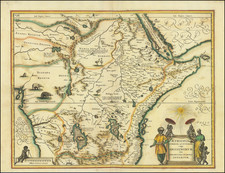Christian Missions Lifting the Blackness from Africa.
Fascinating large format separate map of Madagascar (with insets of Zululand and Natal) showing the extent of Norwegian and other missionary work on the African island.
The map is ascribed to N. Landmark, seemingly an associate of Det Norske Missionsselskabs Forlag (The Norwegian Missions Society Publishers), and was published in Oslo in 1892. It also includes coverage of Zululand and Natal, on the southeast coast of Africa.
The extensive text on the right of the map lists facts about Madagascar and compares the island and Norway (e.g., it was estimated to have a population of 4 million or twice that of Norway).
Lifting Blackness from Africa
The map utilizes rich color lithography in a multi-layered and fraught manner of thematic mapping. The basic concept of the map is that Christian missionaries had brought light to the previously benighted people of the island. This point is further established by the inset map in the upper-left corner, which shows Madagascar almost thirty years earlier, in 1866, as completely black but for a small dot of light around Antananarivo.
The coloring scheme is described in detail in the text on the right side of the map. Translated, it reads:
Black: The areas whose entire native population is heathen and where no mission has hitherto been carried on.
Shaded: The areas where paganism lingers, but where individual Christian congregations have also been formed and missions are out here and there.
Bright: Where Christianity has gained entry, so that the power of paganism in the outside has been broken.
The religious implications of this mapping cannot be easily disentangled from a fundamental concept that characterized European thinking about Africa in the 19th century. Namely, that the Blackness of Africa (personified by its peoples and the still-relatively-poorly-known-to-Europeans state of its geography) could be diminished or erased by the agents of European culture (in the form of missionaries, explorers, colonists, etc.) Coming as it did only a handful of years after the Berlin Conference, this map reflects European thinking about Africa at a pivotal moment in the continent's history.
Rarity
We have not previously encountered a map that so starkly illustrates the European mindset towards Africa from the latter part of the 19th century.
More specifically, this map is extremely rare. We locate no examples of the map having traded. We locate only a single example in OCLC at the Staatsbibliothek zu Berlin.









![Islands in the Atlantic [Bermuda, Madeira, Canaries, Azores and Cape Verde Islands]](https://storage.googleapis.com/raremaps/img/small/48868.jpg)

![IX. b [East Africa]](https://storage.googleapis.com/raremaps/img/small/93300.jpg)
![[Lake Tanganyika, Lake Victoria and Northwest Tanzania]](https://storage.googleapis.com/raremaps/img/small/63611.jpg)
![[Port Louis, Mauritius] Legende du Plan du Port-Louis](https://storage.googleapis.com/raremaps/img/small/51740.jpg)
![[Palma, Tenerife, Gomera, Hierro] Isla Canarias 1a. Hoja](https://storage.googleapis.com/raremaps/img/small/79081.jpg)